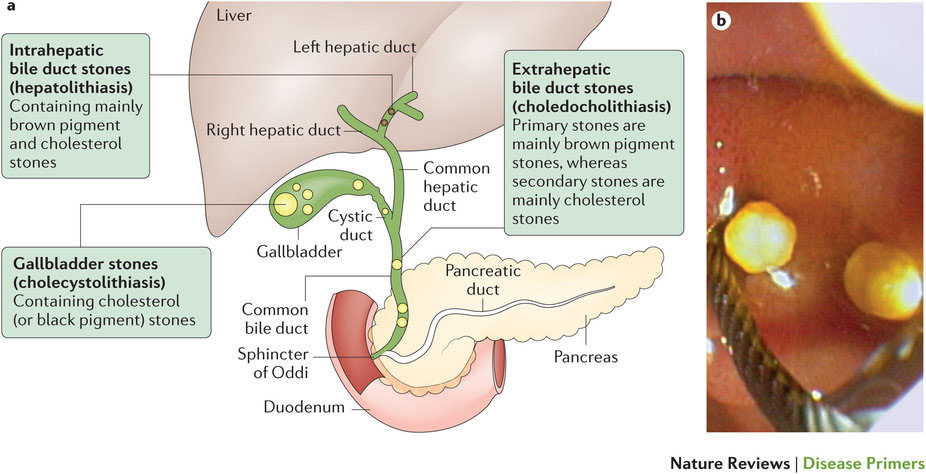胆石症
Gallstones
2016年4月28日 Nature Reviews Disease Primers Article number: 16024 (2016) doi: 10.1038/nrdp.2016.24

胆石は胆嚢または胆道の内部で形成される。これらの胆石には無症候性になるものと症候性になるものがあり、症候または合併症のある胆石のみを胆石症と定義している。胆石は、その構成成分によって、胆石の大部分を占めるコレステロール系胆石とビリルビン系(“色素”)石に分けられる。慢性溶血によって黒色胆石が形成されることがある一方、閉塞および感染した胆管では褐色胆石が形成されることが一般的である。胆石の構成成分よりも胆道内での存在部位のほうが治療に重要である。概して、成人の最大20%が胆石を有しており、さらにその20%以上が症状もしくは合併症を発症する。胆石のリスク因子は、女性、年齢、妊娠、運動不足、肥満および栄養過多である。メタボリックシンドロームに関与する因子は、胆石症の発症リスクも増加するため、生活習慣の修正による一次予防の基礎を成している。肝臓のコレステロール輸送体遺伝子である ABCG8 によく見られる変異は、胆石症発症の遺伝的リスクの大部分を占め、全リスクの約25%に相当する。診断は主に、臨床症状、腹部超音波検査および肝臓生化学検査に基づいて行われる。胆石の症状は、生命を脅かすことがある3種のよく見られる胆石合併症(急性胆嚢炎、急性胆管炎および胆道膵炎)の発症に先立って発現することが多い。近年、胆石の遺伝的特徴および病態生理に関する我々の知識は拡大しているが、現在の治療アルゴリズムは依然として侵襲的方法が中心であり、外科手術が基本になっている。したがって、今後、胆石症の発症を克服する新しい予防戦略に焦点を合わせるべきだが、それはリスクを有する患者はもとより、一般集団についても検討していく必要がある。
PrimeView
成人の10~20%が生涯に胆石を保有することになり、その20%以上が症状もしくは合併症を発症する。このPrimeViewでは、遺伝的特徴、民族性、性別、年齢、薬剤、寄生虫、栄養過多、妊娠などの最もよく見られるリスク因子に焦点を合わせる。
本Primerの図解サマリー

